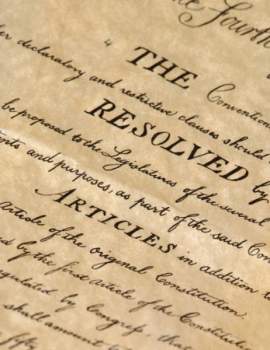
An Overview of the 2nd Amendment

Popular In Constitution
Purpose Of Lifetime Appointment And Pros And Cons Enumerated Powers Bicameral Legislature Background Article 3 Of The Constitution We The People 1st Amendment Who Wrote The Constitution Judicial Review Equal Protection Clause Three Fifths Compromise 10th Amendment 5th Amendment
Second Amendment: The right to bear arms
What is the Second Amendment?
There are two principle versions of the Second Amendment: one version was passed by Congress, while the other is found in the copies distributed to each individual state and later ratified by them
As passed by the Congress:A well-regulated Militia, being necessary to the security of a Free State, the right of the people to keep and bear Arms, shall not be infringed.
As ratified by the States: A well-regulated militia being necessary to the security of a free State, the right of the People to keep and bear arms shall not be infringed.
The Second Amendment Defined:
The Second Amendment is a part of the Bill of Rights, which are the first 10 Amendments to the United States Constitution and the framework to elucidate upon the freedoms of the individual. The Bill of Rights were proposed and sent to the states by the first session of the First Congress. They were later ratified on December 15, 1791.
The first 10 Amendments to the United States Constitution were introduced by James Madison as a series of legislative articles and came into effect as Constitutional Amendments following the process of ratification by three-fourths of the States on December 15, 1791.
Stipulations of the 2nd Amendment:
The Second Amendment to the United States Constitution protects the right of the individual to keep and bear firearms.
The right to arm oneself is viewed as a personal liberty to deter undemocratic or oppressive governing bodies from forming and to repel impending invasions. Furthermore, the right to bear arms was instituted within the Bill of Rights to suppress insurrection, participate and uphold the law, enable the citizens of the United States to organize a militia, and to facilitate the natural right to self-defense.
The Second Amendment was developed as a result of the tyrannous rule of the British parliament. Colonists were often oppressed and forced to pay unjust taxes at the hand of the unruly parliament. As a result, the American people yearned for an Amendment that would guarantee them the right to bear arms and protect themselves against similar situations. The Second Amendment was drafted to provide for the common defense and the general welfare of the United States through the ability to raise and support militias.
Court Cases Tied into the Second Amendment
In District of Columbia v. Heller the Supreme Court ruled that the Second Amendment protects an individual’s right to possess a firearm to use for traditionally lawful purposes, such as defending oneself within their home or on their property. The court case ruled that the Amendment was not connected to service in a militia.
Controversy
The gun debate in the United States widely revolves around the intended interpretation of the Second Amendment. Those who support gun rights claim that the founding fathers developed and subsequently ratified the Second Amendment to guarantee the individual’s right to keep and bear arms. Those who want more stringent gun laws feel that the founding fathers directed this Amendment solely to the formation of militias and are thus, at least by theory, archaic.
State Timeline for Ratification of the Bill of Rights
New Jersey:November 20, 1789; rejected article II
Maryland:December 19, 1789; approved all
North Carolina:December 22, 1789; approved all
South Carolina: January 19, 1790; approved all
New Hampshire: January 25, 1790; rejected article II
Delaware: January 28, 1790; rejected article I
New York: February 27, 1790; rejected article II
Pennsylvania: March 10, 1790; rejected article II
Rhode Island: June 7, 1790; rejected article II
Vermont: November 3, 1791; approved all
Virginia: December 15, 1791; approved all
NEXT: Third Amendment




















